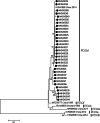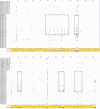Epidemiological investigation of porcine circovirus type 2 and its coinfection rate in Shandong province in China from 2015 to 2018
- PMID: 33413367
- PMCID: PMC7792206
- DOI: 10.1186/s12917-020-02718-4
Epidemiological investigation of porcine circovirus type 2 and its coinfection rate in Shandong province in China from 2015 to 2018
Abstract
Background: Porcine circovirus type 2 (PCV2) is one of the crucial swine viral pathogens, caused porcine circovirus associated diseases (PCVAD). Shandong province is one of the most important pork producing areas and bears a considerable economic loss due to PCVAD. However, there is limited information on epidemiology and coinfection rate of PCV2 with other critical swine diseases in this area, such as porcine reproductive and respiratory syndrome virus (PRRSV), classical swine fever virus (CSFV), Pseudorabies virus (PRV), and porcine epidemic diarrhea virus (PEDV).
Results: Overall, 89.59% serum samples and 36.98% tissue samples were positive for PCV2 specified ELISA and PCR positive for PCV2, respectively. The coinfection rates of PCV2 with PRRSV, PRV, CSFV, and PEDV were 26.73%, 18.37%, 13.06%, and 3.47%, respectively. Moreover, genetic characteristic of PCV2 were analyzed based on the cap genes showing that PCV2d is the dominant sub-genotype circulating in the province.
Conclusions: Our findings reveal that PCV2d, as the dominant strain, is prevailing in pig farms in Shandong province at high levels. There was a high frequency of coinfection of PCV2 and PRRSV.
Keywords: Coinfection; Phylogenetic analysis; Porcine circovirus; Shandong province; Veterinary epidemiology.
Conflict of interest statement
The authors declare that they have no competing interests.
Figures


Similar articles
-
Epidemiological investigation of porcine pseudorabies virus and its coinfection rate in Shandong Province in China from 2015 to 2018.J Vet Sci. 2020 May;21(3):e36. doi: 10.4142/jvs.2020.21.e36. J Vet Sci. 2020. PMID: 32476312 Free PMC article.
-
Prevalence of Porcine Pseudorabies Virus and Its Coinfection Rate in Heilongjiang Province in China from 2013 to 2018.Viral Immunol. 2020 Oct;33(8):550-554. doi: 10.1089/vim.2020.0025. Epub 2020 May 12. Viral Immunol. 2020. PMID: 32397944
-
Co-infection status of classical swine fever virus (CSFV), porcine reproductive and respiratory syndrome virus (PRRSV) and porcine circoviruses (PCV2 and PCV3) in eight regions of China from 2016 to 2018.Infect Genet Evol. 2019 Mar;68:127-135. doi: 10.1016/j.meegid.2018.12.011. Epub 2018 Dec 17. Infect Genet Evol. 2019. PMID: 30572028
-
Co-Infection of Swine with Porcine Circovirus Type 2 and Other Swine Viruses.Viruses. 2019 Feb 21;11(2):185. doi: 10.3390/v11020185. Viruses. 2019. PMID: 30795620 Free PMC article. Review.
-
Porcine circovirus type 2 in China: an update on and insights to its prevalence and control.Virol J. 2014 May 14;11:88. doi: 10.1186/1743-422X-11-88. Virol J. 2014. PMID: 24885983 Free PMC article. Review.
Cited by
-
Seroprevalence of Viral Enzootic Diseases in Swine Backyard Farms in Serbia.Animals (Basel). 2023 Nov 3;13(21):3409. doi: 10.3390/ani13213409. Animals (Basel). 2023. PMID: 37958164 Free PMC article.
-
Impact of porcine circovirus type 2 on porcine epidemic diarrhea virus replication in the IPI-FX cell line depends on the order of infection.Front Microbiol. 2023 Mar 30;14:1162104. doi: 10.3389/fmicb.2023.1162104. eCollection 2023. Front Microbiol. 2023. PMID: 37065133 Free PMC article.
-
Porcine Circovirus Type 3 (PCV3) in Poland: Prevalence in Wild Boar Population in Connection with African Swine Fever (ASF).Viruses. 2024 May 10;16(5):754. doi: 10.3390/v16050754. Viruses. 2024. PMID: 38793635 Free PMC article.
-
The Prevalence and Genetic Characteristics of Porcine Circovirus Type 2 in Shandong Province, China, 2018-2020.Curr Issues Mol Biol. 2024 Nov 26;46(12):13542-13553. doi: 10.3390/cimb46120809. Curr Issues Mol Biol. 2024. PMID: 39727937 Free PMC article.
-
A Subunit Vaccine Harboring the Fusion Capsid Proteins of Porcine Circovirus Types 2, 3, and 4 Induces Protective Immune Responses in a Mouse Model.Viruses. 2024 Dec 23;16(12):1964. doi: 10.3390/v16121964. Viruses. 2024. PMID: 39772270 Free PMC article.
References
MeSH terms
Grants and funding
LinkOut - more resources
Full Text Sources
Other Literature Sources
Miscellaneous

